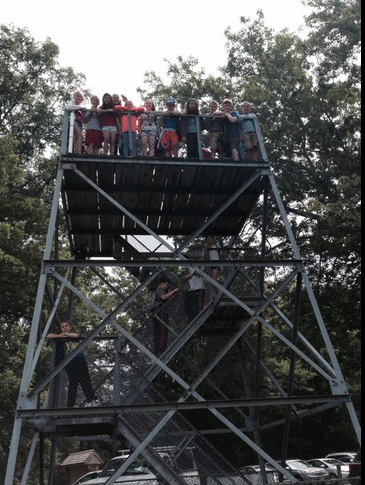 |
| Students look out over The Great Meadows National Wildlife Refuge. |
Many efforts are in place at our school to develop land and water stewards. Throughout the grades, students study the life cycle of chickens, frogs, and butterflies, maple sugaring, gardening/plants, endangered species, habitats, and ecosystems.
 |
| Students had an impromptu chance to learn with turtle expert, Dr. Windmiller. |
We want students to understand the complexity and beauty of their local ecosystems as well as ecosystems far from our school. We want them to have an appreciation of the natural world and a desire to care for and protect the land, animals, and waterways near and far.
Most recently, at the fourth and fifth grades, we've developed a deeper learning relationship with Audubon's Drumlin Farm. Working with the naturalists there, students have had the chance to visit the farm a number of times to learn about animal adaptation, habitats, and the history of the land and people. Working with Drumlin Farm and the support of a SUASCO grant, the students have also had the chance to learn about the Sudbury, Assabet, and Concord Rivers watershed with classroom visits by Drumlin's naturalists and field studies at Great Meadows National Wildlife Refuge in Concord and Sudbury. We also supported the study at school by exploring a small patch of woodsy land next to our school grounds.
 |
| Ponding is a favorite student naturalist' activity. |
I believe our efforts so far have been strong and meaningful, and now I'm thinking about the next steps with attention to the Massachusetts Department of Elementary and Secondary Education (DESE) proposed Science Framework and Next Generation Science Standards. I'm also thinking about this with respect to the emphasis on informational text, research/presentation skills, measurement, data and statistics, and multimedia literacy integrated with the ELA and Math CCSS.
For starters, we'll employ the following efforts:
- We'll continue to work with Robin Stuart and the Drumlin Farm staff to grow our field study naturalist focus. I'll meet with Robin this summer to plan next year's exploration. We've talked about making exploration groups smaller and more independent for the next investigation. We've also discussed focusing on one animal population as part of our work. We employed an "Amazing Adventure" style field study approach where smaller groups led by one or two chaperones/educators traversed Great Meadows as they followed a learning/exploration guide. We also focused in on the spade foot toad by raising endangered spadefoot toad tadpoles which were later released into a newly created habitat at Drumlin Farm.
- We'll write a Wayland Foundation Grant for Naturalist Materials such as binoculars, magnifying lens containers, nets, thermometers, water testing kits, and more. We wrote the grant and were awarded the materials which supported our study.
- We will continue to develop our science library with wonderful books, guides, and CCSS reading/writing materials.The reading, writing, and science research educators on the team brought in many articles that related to our study. Some of us read the novel, The Night of the Spadefoot Toads which was a perfect connection to our study.
- We'll look for opportunities to integrate with grade levels above and below fifth grade to create a nice flow of learning and integration with a variety of learning opportunities. We actually integrated high school students into the study. Robin Stuart provided the high school naturalist class with a naturalist guide presentation. Later the high school students led our students on a nature walk in our nearby Dudley Brook wetlands/forest area. Our kindergarten buddies visited us to see the spadefoot tadpoles, but we didn't extend that study as much--this is something we may want to think about more for 2016-2017.
- I'll learn more about our school conservation efforts championed by our Green Team and work to develop my skill and students' ability to reduce, reuse, and recycle.We reached out to local Green Team and Wayland/Framingham Transition experts. They came in to teach us about living systems and composting. Next year we'd like to do some worm composting in the classroom as well and a local Green Team member has volunteered to support that effort. We also had a surprise and related visit by a NASA engineer that supported our efforts and our grade-level STEAM projects, in part, also contributed to this study. We can continue to develop these relationships as well as grow the connected STEAM curriculum too. Further a Grassroots Wildlife Conservation biologist came to speak to us about the wood frog and spadefoots--her presentation was outstanding!
